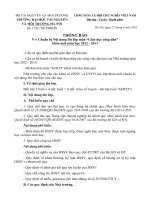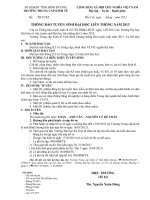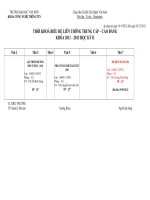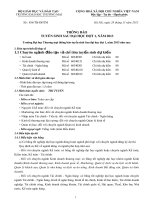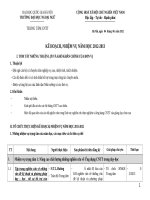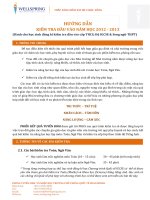Pocket ICU 2013
Bạn đang xem bản rút gọn của tài liệu. Xem và tải ngay bản đầy đủ của tài liệu tại đây (20.95 MB, 565 trang )
Pocket
ICU
Pocket
ICU
Edited by
GYORGY FRENDL, MD, PhD
Assistant Professor of Anesthesia
Harvard Medical School
Director of Research, Surgical Critical Care
Brigham and Women’s Hospital
Boston, Massachusetts
RICHARD D. URMAN, MD, MBA
Assistant Professor of Anesthesia
Harvard Medical School
Director, Procedural Sedation Management and Safety
Brigham and Women’s Hospital
Boston, Massachusetts
Acquisitions Editor: Brian Brown
Product Manager: Nicole Dernoski
Production Manager: Alicia Jackson
Senior Manufacturing Manager: Benjamin Rivera
Marketing Manager: Lisa Lawrence
Design Coordinator: Doug Smock
Production Service: Aptara, Inc
© 2013 by LIPPINCOTT WILLIAMS & WILKINS, a WOLTERS KLUWER
business
Two Commerce Square
2001 Market Street
Philadelphia, PA 19103 USA
LWW.com
All rights reserved. This book is protected by copyright. No part of this book may be reproduced in any form by any means, including
photocopying, or utilized by any information storage and retrieval system without written permission from the copyright owner, except for
brief quotations embodied in critical articles and reviews. Materials appearing in this book prepared by individuals as part of their official
duties as U.S. government employees are not covered by the above-mentioned copyright.
Printed in China
Library of Congress Cataloging-in-Publication Data
Pocket ICU / [edited by] Gyorgy Frendl, Richard D. Urman.
p. ; cm. – (Pocket notebook series)
Includes bibliographical references and index.
ISBN 978-1-4511-0984-9 (alk. paper)
I. Frendl, Gyorgy. II. Urman, Richard D. III. Series: Pocket notebook.
[DNLM: 1. Intensive Care–methods–Handbooks. 2. Individualized
Medicine–Handbooks. 3. Intensive Care Units–Handbooks. WX 39]
616.02′8–dc23
2012010729
Care has been taken to confirm the accuracy of the information presented and to describe generally accepted practices. However, the
authors, editors, and publisher are not responsible for errors or omissions or for any consequences from application of the information in
this book and make no warranty, expressed or implied, with respect to the currency, completeness, or accuracy of the contents of the
publication. Application of the information in a particular situation remains the professional responsibility of the practitioner.
The authors, editors, and publisher have exerted every effort to ensure that drug selection and dosage set forth in this text are in
accordance with current recommendations and practice at the time of publication. However, in view of ongoing research, changes in
government regulations, and the constant flow of information relating to drug therapy and drug reactions, the reader is urged to check the
package insert for each drug for any change in indications and dosage and for added warnings and precautions. This is particularly
important when the recommended agent is a new or infrequently employed drug.
Some drugs and medical devices presented in the publication have Food and Drug Administration (FDA) clearance for limited use in
restricted research settings. It is the responsibility of the health care provider to ascertain the FDA status of each drug or device planned
for use in their clinical practice.
To purchase additional copies of this book, call our customer service department at (800) 638-3030 or fax orders to (301) 223-2320.
International customers should call (301) 223-2300.
Visit Lippincott Williams & Wilkins on the Internet: at LWW.com. Lippincott Williams & Wilkins customer service representatives are
available from 8:30 am to 6 pm, EST.
10 9 8 7 6 5 4 3 2 1
CONTRIBUTORS
Rae Allain
Harvard Medical School
Boston, Massachusetts
Edwin Pascal Alyea, III
Harvard Medical School
Boston, Massachusetts
Karim Awad
Harvard Medical School
Boston, Massachusetts
Lindsey Baden
Harvard Medical School
Boston, Massachusetts
Rebecca M. Baron, MD
Harvard Medical School
Boston, Massachusetts
Sheri Berg
Harvard Medical School
Boston, Massachusetts
Tarun Bhalla, MD, FAAP
The Ohio State University Medical Center
Columbus, Ohio
Wenya Linda Bi, MD, PhD
Harvard Medical School
Boston, Massachusetts
Nathan E. Brummel, MD
Vanderbilt University School of Medicine
Nashville, Tennessee
Phillip Camp
Harvard Medical School
Boston, Massachusetts
Kenneth B. Christopher, MD
Harvard Medical School
Boston, Massachusetts
Marcus D. Darrabie, MD
Duke University Medical
Center Durham, North Carolina
Christian Denecke, MD
Innsbruck Medical University
Innsbruck, Austria
J. Rodrigo Diaz-Siso
Harvard Medical School
Boston, Massachusetts
Karim Djekeidel
Drexel University College of Medicine
Philadelphia, Pennsylvania
Anquenetta L. Douglas
Johns Hopkins School of Medicine
Baltimore, Maryland
Ian F. Dunn
Harvard Medical School
Boston, Massachusetts
Brian Edlow
Harvard Medical School
Boston, Massachusetts
Ali A. El-Solh
University at Buffalo
Buffalo, New York
E. Wesley Ely, MD, MPH
Vanderbilt University Medical Center
Nashville, Tennessee
Peter J. Fagenholz, MD
Harvard Medical School
Boston, Massachusetts
Michael G. Fitzsimons
Harvard Medical School
Boston, Massachusetts
Gyorgy Frendl
Harvard Medical School
Boston, Massachusetts
Dragos M. Galusca, MD
Johns Hopkins Medical Institutions
Baltimore, Maryland
Samuel M. Galvagno, Jr., DO, PhD
University of Maryland School of Medicine
Baltimore, Maryland
Brett Glotzbecker
Harvard Medical School
Boston, Massachusetts
William B. Gormley
Harvard Medical School
Boston, Massachusetts
David Greer
Harvard Medical School
Boston, Massachusetts
Michael Gropper
University of California San Francisco
San Francisco, California
Hiroto Hatabu
Harvard Medical School
Boston, Massachusetts
Joaquim M. Havens, MD
Harvard Medical School
Boston, Massachusetts
Galen V. Henderson
Harvard Medical School
Boston, Massachusetts
Kathryn A. Hibbert, MD
Harvard Medical School
Boston, Massachusetts
Jennifer Hofer, MD
The University of Chicago Medical Center
Chicago, Illinois
Peter C. Hou, MD
Harvard Medical School
Boston, Massachusetts
Danny O. Jacobs
Duke University School of Medicine
Durham, North Carolina
George Kasotakis, MD
Harvard Medical School
Boston, Massachusetts
Edward Kelly
Harvard Medical School
Boston, Massachusetts
Emily Z. Keung, MD
Harvard Medical School
Boston, Massachusetts
George Koenig
Jefferson Medical College
Philadelphia, Pennsylvania
Yasser El Kouatli
University of Michigan Health System
Ann Arbor, Michigan
John P. Kress
University of Chicago
Chicago, Illinois
Kelly B. Kromer
Harvard Medical School
Boston, Massachusetts
Peggy S. Lai, MD
Harvard Medical School
Boston, Massachusetts
Col. Geoffrey S.F. Ling
Medical Corps, US Army
Arlington, Virginia
Tensing Maa, MD
Ohio State University Medical Center
Columbus, Ohio
Sayeed K. Malek, MD, FACS
Harvard Medical School
Boston, Massachusetts
Atul Malhotra
Harvard Medical School
Boston, Massachusetts
Ernest I. Mandel, MD
Harvard Medical School
Boston, Massachusetts
Oveys Mansuri
University of Nebraska College of Medicine
Omaha, Nebraska
Shannon S. McKenna, MD
Harvard Medical School
Boston, Massachusetts
Brijesh P. Mehta, MD
Harvard Medical School
Boston, Massachusetts
Alessandro M. Morandi
Vanderbilt University School of Medicine
Nashville, Tennessee
Lena M. Napolitano
University of Michigan Health System
Ann Arbor, Michigan
Emily Nelson
Harvard Medical School Brigham and Women’s Hospital
Boston, Massachusetts
Patrice K. Nicholas
Massachusetts General Hospital
Boston, Massachusetts
Chong Nicholls
Harvard Medical School
Boston, Massachusetts
Heikki Nikkanen
Harvard Medical School
Boston, Massachusetts
John J. O’Connor, Jr., MD
South Shore Hospital
South Weymouth, Massachusetts
Michael F. O’Connor, MD, FCCM
University of Chicago Medical Center
Chicago, Illinois
Yuka Okajima
Harvard Medical School
Boston, Massachusetts
David Oxman
Jefferson Medical College
Philadelphia, Pennsylvania
Bhakti K. Patel
University of Chicago
Chicago, Illinois
Mary Pennington
Brigham and Women’s Hospital
Boston, Massachusetts
Sujatha Pentakota, MD
Harvard Medical School
Boston, Massachusetts
Bohdan Pomahac, MD
Harvard Medical School
Boston, Massachusetts
Pankajavalli Ramakrishnan
Harvard Medical School
Boston, Massachusetts
Mary B. Rice, MD
Harvard Medical School
Boston, Massachusetts
Steven A. Ringer
Harvard Medical School
Boston, Massachusetts
Angela J. Rogers, MD
Harvard Medical School
Boston, Massachusetts
Selwyn O. Rogers, Jr., MD, MPH
Harvard Medical School
Boston, Massachusetts
Allan Ropper
Harvard Medical School
Boston, Massachusetts
Daniel S. Rubin, MD
University of Chicago
Chicago, Illinois
Amod Sawardekar
Northwestern University Feinberg School of Medicine
Chicago, Illinois
Raghu Seethala
Harvard Medical School
Boston, Massachusetts
Mouhsin Shafi
Harvard Medical School
Boston, Massachusetts
Sajid Shahul
Harvard Medical School
Boston, Massachusetts
Peter H. Stone
Harvard Medical School
Boston, Massachusetts
Daniel S. Talmor, MD, MPH
Harvard Medical School
Boston, Massachusetts
Candice Tam
University of California San Francisco
San Francisco, California
Stefan G. Tullius, MD, PhD, FACS
Harvard Medical School
Boston, Massachusetts
Avery Tung
University of Chicago School of Medicine
Chicago, Illinois
Dirk J. Varelmann, MD, DESA, EDIC
Harvard Medical School
Boston, Massachusetts
George Velmahos
Harvard Medical School
Boston, Massachusetts
Binbin Wang
University of California San Francisco
San Francisco, California
M. Brandon Westover, MD, PhD
Harvard Medical School
Boston, Massachusetts
Lashonda Williams
East Texas Medical Center
Tyler, Texas
Neil J. Wimmer
Harvard Medical School
Boston, Massachusetts
Traci A. Wolbrink, MD, MPH
Harvard Medical School
Boston, Massachusetts
PREFACE
Critical care has always been a multi-disciplinary specialty. The multidisciplinary nature is
practiced two ways: (a) critical care integrates knowledge and practices from many medical
specialties (trauma, transplant medicine, cardiology, pulmonary medicine, anesthesiology and pain
medicine, and many others); and (b) it requires the close collaboration of medical professionals
from many specialties (nurses, physico-therapists, respiratory therapists, nutritionists, pharmacists,
physicians, etc.). For that, critical care professionals are required to be masters of communication,
team building, and management.
Since its inception in the polio era (1950s), critical care has grown beyond adolescence and
now is considered to be an evidence-based specialty. Dozens of high-quality clinical trials built a
solid scientific foundation for critical care, and allowed us to significantly improve both patient
survival and quality of life following critical illness. Our mission was to highlight these for our
readers.
As we reach for personalized (individualized) medicine to custom tailor our management for
every one of our patients, provide care for the elderly in their 80s and 90s, treat diseases that were
untreatable just years before, the knowledge has to be solid and the commitment firm that critical
care professionals will always put their patients first. The challenges remaining are substantial and
will require a well-trained, collaborative, patient-centered and cost-effective effort from all of us.
This book is intended to provide concise, evidence-based information for all critical care
professionals, as well as for those who are having their first encounter with ICUs and critically ill
patients. To accomplish our goals, we were joined by many leading critical care specialists. We
are grateful for their contribution and for sharing their many years of experience.
The rewards of providing care for the most needy are great. With our book, we invite all of you
for a great and satisfying professional journey.
GYORGY FRENDL, MD, PhD
RICHARD D. URMAN, MD, MBA
Harvard Medical School
Boston, Massachusetts
CONTENTS
Contributors
Preface
COMMON ICU PROBLEMS
Raghu Seethala
MONITORING
Samuel M. Galvagno, Jr. and Anquenetta L. Douglas
MECHANICAL VENTILATION AND PULMONARY ISSUES
Rebecca M. Baron
AIRWAY MANAGEMENT
Tarun Bhalla, Tensing Maa, and Amod Sawardekar
ACUTE LUNG INJURY (ALI) AND ACUTE RESPIRATORY DISTRESS SYNDROME
(ARDS)
John J. O’Connor and Daniel S. Talmor
HEMATOLOGY, FLUID AND ELECTROLYTE MANAGEMENT
Yasser El Kouatli and Lena M. Napolitano
ACID–BASE MANAGEMENT
Mary B. Rice, Kathryn A. Hibbert, and Atul Malhotra
ANALGESIA, SEDATION, AND DELIRIUM
Nathan E. Brummel, Alessandro M. Morandi, and E. Wesley Ely
NUTRITION
Marcus D. Darrabie and Danny O. Jacobs
INFECTIOUS DISEASE, SEPSIS, AND THE SURVIVING SEPSIS GUIDELINES
David Oxman, Karim Djekeidel, Gyorgy Frendl, Lindsey Baden
ENDOCRINE AND RENAL ISSUES
Ernest I. Mandel and Kenneth B. Christopher
SCORING SYSTEMS FOR THE SEVERITY OF ILLNESS
Edward Kelly
PREVENTIVE STRATEGIES AND EVIDENCE-BASED PRACTICE
Shannon S. McKenna
ADVANCED CARDIAC LIFE SUPPORT (ACLS)
Dragos M. Galusca
GENERAL TRAUMA I
Joaquim M. Havens, George Koenig, and Samuel M. Galvagno, Jr.
GENERAL TRAUMA II
Peter J. Fagenholz, George Kasotakis, and George Velmahos
BURN MANAGEMENT
Emily Z. Keung and Joaquim M. Havens
HEAD TRAUMA AND SPINAL CORD INJURY
Wenya Linda Bi, William B. Gormley, and Ian F. Dunn
NEUROLOGICAL CRITICAL CARE
Brian Edlow, Brijesh P. Mehta, Pankajavalli Ramakrishnan, and Allan Ropper
NEUROVASCULAR CRITICAL CARE
Karim Awad and David Greer
SEIZURES
M. Brandon Westover and Mouhsin Shafi
WEAKNESS IN THE CRITICAL Care Setting
Galen V. Henderson
ACUTE CORONARY SYNDROMES AND MYOCARDIAL ISCHEMIA
Neil J. Wimmer and Peter H. Stone
CARDIAC SURGICAL CRITICAL CARE
Candice Tam, Binbin Wang, and Michael Gropper
HEART AND LUNG TRANSPLANTATION
Phillip Camp
LIVER, KIDNEY, AND PANCREAS TRANSPLANTATION
Christian Denecke, Stefan G. Tullius, and Sayeed K. Malek
BONE MARROW AND STEM CELL TRANSPLANTATION
Brett Glotzbecker and Edwin Pascal Alyea, III
PLASTIC SURGICAL CRITICAL CARE
J. Rodrigo Diaz-Siso and Bohdan Pomahac
THORACIC SURGICAL CRITICAL CARE
Shannon S. McKenna
VASCULAR SURGICAL CRITICAL CARE
Sheri Berg and Rae Allain
NEONATAL INTENSIVE CARE
Steven A. Ringer
PEDIATRIC INTENSIVE CARE
Kelly B. Kromer and Traci A. Wolbrink
OBSTETRIC CRITICAL CARE
Dirk J. Varelmann
OBESITY: SPECIAL CONSIDERATIONS
Ali A. El-Solh
THE ELDERLY: SPECIAL CONSIDERATIONS
Alessandro M. Morandi, Nathan E. Brummel, and E. Wesley Ely
TOXICOLOGY
Heikki Nikkanen
DISASTER PREPAREDNESS
Geoffrey S.F. Ling
INFORMED CONSENT, PROCEDURAL STANDARDIZATION AND SAFETY
Jennifer Hofer
COMMON PROCEDURES
Jennifer Hofer and Avery Tung
BEDSIDE SURGICAL PROCEDURES
Oveys Mansuri, Lashonda Williams, and Selwyn O. Rogers, Jr.
ULTRASOUND-GUIDED THERAPY AND PROCEDURES
Sajid Shahul and Gyorgy Frendl
RADIOLOGIC IMAGING
Yuka Okajima and Hiroto Hatabu
NURSING STANDARDS IN CRITICAL CARE
Mary Pennington
OCCUPATIONAL AND PHYSICAL THERAPY
Bhakti K. Patel and John P. Kress
TRANSITIONING FROM ACUTE CARE TO REHABILITATION
Shannon S. McKenna
PATIENT- AND FAMILY-CENTERED CARE
Mary Pennington and Patrice K. Nicholas
ETHICS AND PALLIATIVE/END OF LIFE CARE
Michael F. O’Connor and Daniel J. Rubin
INTER AND INTRA-HOSPITAL TRANSPORT OF CRITICALLY ILL PATIENTS
Michael G. Fitzsimons and Chong Nicholls
OPERATING ROOM: CARING FOR THE EXTREMELY CRITICALLY ILL PATIENT
Emily Nelson and Gyorgy Frendl
EMERGENCY DEPARTMENT TO ICU COMMUNICATION STRATEGIES
Peter C. Hou
GENOMICS IN CRITICAL CARE
Peggy S. Lai and Angela J. Rogers
APPENDIX: ICU CALCULATORS, CALCULATIONS, DRUGS
Sujatha Pentakota
APPENDIX: STATISTICS AND EVIDENCE-BASED MEDICINE (EBM)
Sujatha Pentakota
INDEX
COMMON ICU PROBLEMS
RAGHU SEETHALA, MD
HYPERKALEMIA
Serum K > 5.0 mmol/l, severe hyperkalemia > 6.0 mmol/l (also see Chapter 6)
Causes
• Renal insufficiency
• Adrenal insufficiency
• Insulin deficiency
• Tissue damage from rhabdomyolysis, trauma, or burns
• Medication related
• Acidosis
Clinical Manifestations
• Peaked T waves on ECG; hyperkalemia depolarizes cardiac membrane leading to further EKG
changes, like widening of QRS (sinusoidal wave forms) which can progress to asystole or
ventricular fibrillation
• Muscular effects can include paresthesias, weakness, or flaccid paralysis
Management
• Stabilize cardiac membrane
• Calcium Gluconate (10%) 10 ml IV push over 2–3 min, can repeat q5min
• Shift potassium intracellularly
• Insulin (regular) 10 U IV push with 25 g of Dextrose IV push (if not hyperglycemic)
• Albuterol 15–20 mg (beta-agonist) nebulized over 10 min
• Sodium Bicarbonate 50 mmol IV push or 150 mmol/l IV at a variable rate (only use if patient has
a severe metabolic acidosis)
• Potassium elimination from body
• Furosemide (Lasix) 40–80 mg IV push
• Sodium polystyrene sulfonate (Kayexalate) 15–30 g in 15–30 ml (70% sorbitol PO)
• Do not administer in ileus or bowel obstruction because of risk of colonic necrosis
• Hemodialysis (if hyperkalemia is unresponsive to conservative measures listed above)
SHOCK
Hypoperfusion causing tissue hypoxia resulting in multiorgan dysfunction (also see Chapter 10
for septic and Chapter 27 for cardiogenic shock).
Differential Diagnosis
• Hypovolemic
• Hemorrhage (trauma, GI bleed, retroperitoneal bleed)
• Dehydration (vomiting, diarrhea, GI fistula)
• Third spacing (burns, malnutrition, SIRS)
• Cardiogenic
• Myocardial infarction
• Myocarditis
• End stage cardiomyopathy
• Valvular failure
• Congestive heart failure
• Arrhythmia
• Distributive
• Sepsis
• Anaphylaxis
• Liver failure
• Neurogenic
• Adrenal insufficiency
• Drugs
• Obstructive
• Tension pneumothorax
• Cardiac tamponade
• Constrictive pericarditis
• Pulmonary embolism
• Aortic coarctation
Clinical Manifestations
• Hypotension
• Tachycardia
• Tachypnea
• Mottled skin
• Cool extremities
• Altered mental status
• Decreased urine output
Management
• Establish and maintain ABCs (airway, breathing, circulation)
• Fluid resuscitation
• Blood and blood product transfusion
• Vasopressors
• Inotropes
• Hemodynamic monitoring (CVC, arterial line, PA catheter, echocardiogram)
• Consider the following resuscitation endpoints for septic shock (the most common type of shock)
• CVP 8–12 mm Hg, 12–15 mm Hg if mechanically ventilated
• MAP ≥ 65 mm Hg
• UOP ≥ 0.5 ml/kg/hr
• ScVO2 ≥ 70% or MVO2 ≥ 65%
• Lactate clearance
• Identification and treatment of underlying problem including source control in septic shock
SEPSIS
Infection associated with a systemic inflammatory response (also see Chapter 10).
Causes
• Pneumonia
• Catheter-related blood stream infections
• Sinusitis
• Clostridium difficile
• Intra-abdominal (cholecystitis, abscess, peritonitis)
• UTI, pyelonephritis
• Meningitis, encephalitis
• Cellulitis, necrotizing soft tissue infection, wound infection
• Septic arthritis, osteomyelitis
• Endocarditis
• Fungemia, fungal abscess
Investigations
• CBC, electrolytes, BUN/Cr, PT/INR, LFT
• Blood culture, urine culture, site specific culture
• ABG/lactate
• Procalcitonin
• Imaging studies: chest x-ray, site specific CT scan, US, etc.
Management
• Source identification and control as rapidly as possible
• Broad spectrum IV antibiotic therapy within first hour
• Early goal directed therapy within the first 6 hr
• CVP 8–12 mm Hg, 12–15 mm Hg if mechanically ventilated
• MAP ≥ 65 mm Hg
• UOP ≥ 0.5 ml/kg/hr
• ScVO2 ≥ 70% or MVO2 ≥ 65%
• Fluid therapy to reach above CVP targets
• Administer vasopressors to maintain MAP ≥ 65 mm Hg (norepinephrine with or without
vasopressin as first choice)
• Inotropic therapy with dobutamine for sepsis induced cardiac dysfunction
• May consider corticosteroids when hypotension is not responding to fluid resuscitation and
vasopressors (ACTH stimulation test is no longer recommended).
• Supportive therapy (ARDSnet ventilation strategy, glycemic control to keep blood glucose in the
140–160 mg/dl range, renal replacement, stress ulcer prophylaxis, DVT prophylaxis)
ARRHYTHMIAS
Bradyarrhythmia: HR < 60 bpm
Differential Diagnosis
• SA node dysfunction
• Sinus arrest
• SA conduction block
• Sick sinus syndrome
• AV node dysfunction
• First degree AV block
• Second degree AV block Mobitz type I
• Second degree AV block Mobitz type II
• Third degree AV block
• Junctional escape rhythm
• Ventricular escape rhythm
• Sinus bradycardia
Management
• 12-lead EKG
• Atropine 0.5 mg IV bolus repeat 3–5 min (maximum 3 mg)
• Dopamine IV infusion 2–10 mcg/kg/min
• Epinephrine IV infusion 2–10 mcg/min
• Transcutaneous pacing (consider pacing for symptomatic bradycardias, 3rd degree AV block,
Mobitz type II 2nd degree block)
• Transvenous pacing
• Treat underlying cause
Tachyarrhythmia: HR > 100 bpm
Differential Diagnosis
• Narrow complex tachycardia
• Sinus tachycardia
• Focal atrial tachycardia
• Atrial fibrillation
• Multifocal atrial tachycardia
• Atrial flutter
• Junctional tachycardia
• AV node reentry tachycardia
• AV reentry tachycardia
• Wide complex tachycardia
• Monomorphic VT
• Polymorphic VT
• SVT with aberrancy
• Pre-excitement tachycardia (WPW)
Management
• 12-lead EKG
• If unstable (hypotension, altered mental status, signs of shock) then proceed to synchronized
cardioversion
• Narrow regular 50–100 J biphasic
• Narrow irregular 120–200 J biphasic or 200 J monophasic
• Wide regular: 100 J biphasic; if ineffective, increase J in a stepwise fashion
• Wide irregular: Defibrillation dose (not synchronized)
• Vagal maneuvers for supraventricular tachycardia
• Adenosine 6 mg IV push (if regular) for paroxysmal supraventricular tachycardia
• β-blocker – Metoprolol 2.5–5 mg IV
• Calcium channel blocker – Diltiazem 0.25 mg/kg IV followed by infusion
• Amiodarone 150 mg IV over 10 min (may consider 150 mg iv repeated dose if unresponsive to first
loading dose), followed by maintenance infusion (1 mg/min for 6 hr, reduced to 0.5 mg/min after
that)
• Treat underlying cause
Atrial Fibrillation
Causes
• Alcohol intake
• Autonomic dysfunction
• Cardiac/thoracic surgery
• Cardiomyopathy
• Electrolyte abnormality
• Heart failure
• Hyperthyroidism
• MI
• Pericarditis
• Pulmonary disease
• Valvular heart disease
Management
• If unstable then synchronized cardioversion
• 120–200 J biphasic
• If <48 hr consider cardioversion (DC or pharmacologic)
• Pharmacologic cardioversion – Amiodarone, Sotalol, Ibutilide, Flecainide
• If >48 hr rate control and anticoagulate (if no contraindications)
• Rate control
• Metoprolol 5 mg IV q5min total of 15 mg
• Diltiazem 0.25 mg/kg IV followed by infusion
• Digoxin 0.25 mg IV q2h total of 1.5 mg loading dose
• Amiodarone 150 mg IV over 10 min (may consider 150 mg iv repeated dose if unresponsive to
first loading dose), followed by maintenance infusion (1 mg/min for 6 hr, reduced to 0.5 mg/min
after that)
• Treat underlying cause
HYPOTENSION
MAP < 60 mm Hg, SBP < 90 mm Hg, or decrease in SBP by >40 mm Hg from baseline. MAP = CO
× SVR
Differential Diagnosis
• Decrease in CO
• Decreased preload
• Hypovolemia, hemorrhage, third spacing, decreased venous return, excessive PEEP
• Decreased contractility
• Myocardial infarction, myocarditis, cardiomyopathy, valvular failure, arrhythmia, congestive
heart failure, drugs, electrolyte imbalance
• Obstruction (to inflow or outflow of cardiac pump)
• PE, tension pneumothorax, cardiac tamponade
• Decrease in SVR
• Sepsis, SIRS, anaphylaxis, neurogenic shock, vasodilating drugs, adrenal insufficiency, liver
failure due to decreased SVR
Management
• Hemodynamic monitoring (CVC, arterial line, PA catheter, echo)
• 500 ml NS or LR IVF bolus, then reassess hemodynamics (HR, BP, cardiac output [CO], index
[CI], stroke volume, CVP) and repeat IVF bolus as needed
• Review medications, decrease dose of vasodilating drugs and cardiac depressants (sedatives,
opiods, etc.)
• Vasopressors (norepinephrine, dopamine, phenylephrine, epinephrine)
• Inotropes (dobutamine, milrinone, levosimendan)
• Assess for and treat underlying cause
HYPOXEMIA
PaO2 < 60 mm Hg or SpO2 < 90%
Differential Diagnosis
• Hypoventilation
• COPD, asthma, bronchospasm, inappropriate ventilator settings
• CNS depression – drug overdose, CNS lesion
• Obesity hypoventilation syndrome
• Neuromuscular weakness – myasthenia gravis, critical illness polyneuropathy, Guillain–Barre
syndromé, hypophosphatemia
• V/Q mismatch
• Most common cause of hypoxemia in the ICU
• Imbalance between lung perfusion and ventilation
• Pneumonia, ALI/ARDS, pneumonitis, pulmonary edema, pulmonary embolism
• Right to left shunt
• Intracardiac shunt, pulmonary AVM, hepatopulmonary syndrome
• Diffusion impairment (seen rarely in very advanced pulmonary fibrosis, asbestosis)
• Usually occurs along with V/Q mismatch
• Interstitial lung disease
• Reduced inspired FiO2
• High altitude, equipment failure
Investigations
• SpO2
• ABG – PaO2, PaCO2, A-a gradient
• PaO2/FiO2 ratio
• CXR, CT of chest if needed
Management
• Initially administer 100% FiO2, titrate FiO2 to SpO2 > 90%
• Initiate mechanical ventilation if unresponsive to supplemental O2 therapy
• Appropriate ventilator settings (low tidal volume, higher PEEP, adequate RR)
• Ensure proper position of ET tube
• Bronchoscopy as needed (mucous plug, atelectasis, abundant secretions)
• Bag mask ventilation if considering equipment failure
• Treat underlying cause
P ERICARDIAL TAMPONADE
Accumulation of pericardial fluid under pressure compressing all cardiac chambers resulting in
cardiovascular collapse.
Differential Diagnosis
• Massive PE
• Acute MI with RV involvement
• Constrictive pericarditis
• Large pleural effusion
• Tension pneumothorax
Causes
• Inflammatory – RA, SLE
• Malignancy
• Uremia
• Hypothyroidism
• MI with free wall rupture
• Trauma
• Infectious – viral, TB
• Cardiac interventions – pacemaker placement, cardiac catheterization, heart surgery
Clinical Findings
• Tachycardia, pericardial friction rub
• Beck’s triad – Hypotension, JVD, muffled heart sounds
• Pulsus paradoxus
• Low voltage QRS, Electrical alternans
• Equilibration of diastolic pressures in all chambers of the heart CVP = RVEDP = PCWP = LVEDP
Management
• Diagnosis made with echocardiography
• Optimize preload with IVF bolus in hypovolemic patients
• Consider dobutamine, though heart is usually at maximum inotropic state via endogenous
stimulation
• Definitive therapy is drainage via pericardiocentesis
• Cases of intrapericardial bleeding (trauma, post-op, tumor) usually require surgical intervention
TENSION P NEUMOTHORAX
Progressive accumulation of air in the pleural space that compresses the mediastinum kinking off
venous return leading to cardiovascular collapse.
Differential Diagnosis
• Pericardial tamponade
• Hemothorax
Causes
• Thoracic trauma
• Iatrogenic – CVC placement, transthoracic needle biopsies
• Spontaneous pneumothorax
• Secondary pneumothorax
• Barotrauma from mechanical ventilation
Clinical Findings
• Distended neck veins
• Progressive hypotension (often rapidly severe, may lead to cardiovascular collapse)
• Tracheal deviation to contralateral side
• Absent breath sounds
Management
• Immediate needle decompression with 14–16 gauge needle in the midclavicular line of the second
intercostal space of affected side
• Followed by chest tube placement for definitive therapy
ACUTE MENTAL STATUS CHANGE
A spectrum of states including confusion, delirium, obtundation, stupor and coma.
Differential Diagnosis
• Stroke/hemorrhage
• Seizure
• Encephalitis/meningitis
• Delirium
• Post cardiac arrest brain injury/anoxic encephalopathy
• Drugs (illicit or medication overdose)
• Alcohol withdrawal
• Thiamine deficiency
• Hypo/hyperthyroid
• Adrenal insufficiency
• Hepatic encephalopathy
• Hypo/hyperglycemia
• Hypoxia/hypercarbia
• Electrolyte abnormality (hypo/hypernatremia, hypercalcemia, hypophosphatemia)
• Septic encephalopathy
Investigations
• Vitals signs
• CT head
• Labs – electrolytes, BUN, Cr, CBC, LFTs, ammonia, UA, ABG
• Lumbar puncture to evaluate for meningitis/encephalitis
• EEG to evaluate for nonconvulsive status epilepticus
Management
• Establish and maintain ABCs (airway, breathing, circulation)
• Thiamine 100 mg IV (prior to dextrose to prevent precipitating acute Wernicke’s encephalopathy)
• Dextrose 50 ml of D50W (25 g IV push)
• Naloxone 0.2–0.4 mg by slow (fractioned) IV push if comatose and suspect opiod intoxication
• Search for and treat underlying cause
• Flumazenil 0.2 mg iv maybe repeated 3 more times with a few minute intervals (to reverse the
effects of benzodiazepines; beware of the potential seizures after reversal of benzodiazepine
effect). Do not use in patients that chronically use benzodiazepines: the potential for intractable
seizures is much higher in this group.

